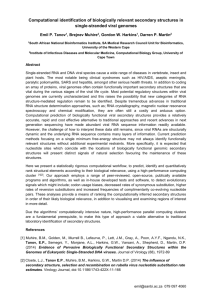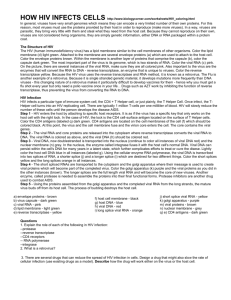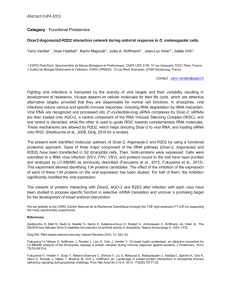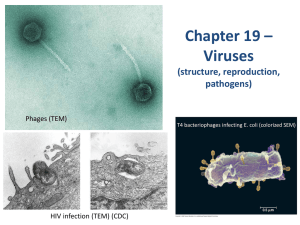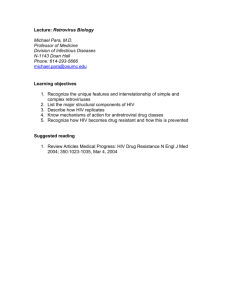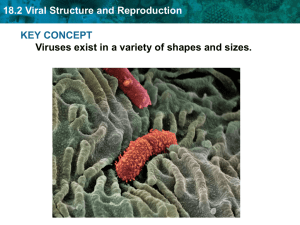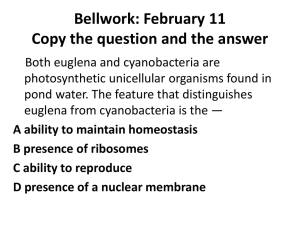HIV - Penn Math
advertisement
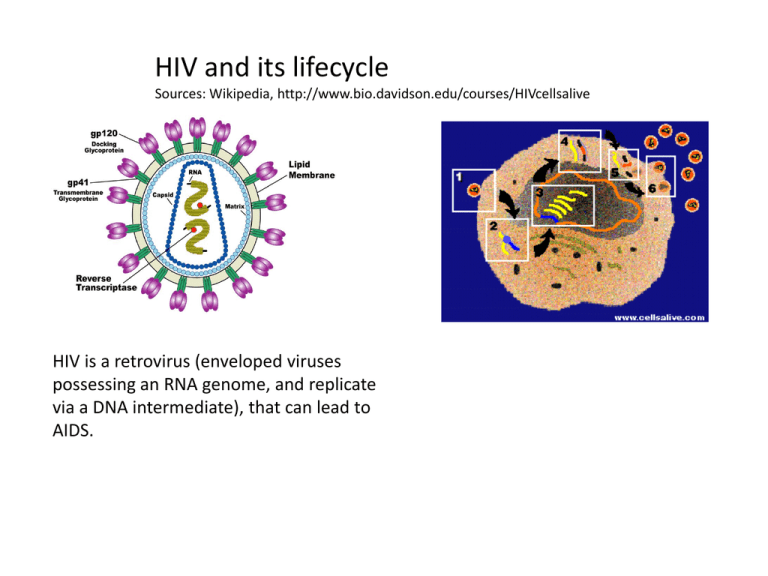
HIV and its lifecycle Sources: Wikipedia, http://www.bio.davidson.edu/courses/HIVcellsalive HIV is a retrovirus (enveloped viruses possessing an RNA genome, and replicate via a DNA intermediate), that can lead to AIDS. Attachment to Lymphocyte membrane HIV sticks to (at least) two receptors on the Tlymphocytes. The primary receptor, called "CD4", is shown on the right in the diagram. But a second receptor that loops through the cell membrane 7 times is critical for infection to occur. HIV infection of a lymphocyte requires attachment of the virus to the cell membrane through both of these "ligand-receptor" links. Entry of the viral RNA Tight attachment of the viral particle to receptors on the lymphocyte membrane enables fusion with the cell membrane. The viral contents, including viral RNA (shown in yellow) then empty into the cell's cytoplasm. Replication Integration, transcription HIV RNA Reverse Transcriptase Complementary DNA Reverse transcriptase, a enzyme that's part of HIV, reads the sequence of viral RNA nucleic acids that have entered the host cell and transcribes the sequence into a complementary DNA sequence. Reverse transcriptase sometimes makes mistakes, leading to point mutations in the RNA and hence different HIV surface proteins, so that HIV can’t be recognized by existing antibodies anymore. Host cell DNA Viral DNA The virus has its own enzyme called "integrase" that facilitates incorporation of the viral DNA into the host cells DNA. T-cell’s RNA viral mRNA polymerase If the lymphocyte is activated, transcription of the viral DNA begins, resulting in the production of multiple copies of viral RNA. Translation Viral protease Protease Protein There are only 9 genes in the HIV RNA. Those genes have the code necessary to produce structural proteins such as the viral envelope and core plus enzymes like reverse transcriptase, integrase, and a crucial enzyme called a protease. When viral RNA is translated into a polypeptide sequence, that sequence is assembled in a long chain that includes several individual proteins (reverse transcriptase, protease, integrase).. Before these enzymes become functional, they must be cut from the longer polypeptide chain. Viral protease cleaves the long chain into its individual enzyme components which then facilitate the production of new viruses. Protease inhibitors (e.g. ritonavir) block the ability of the protease to cleave, so the new virus won’t have its functional enzymes and won’t be able to reproduce. Assembly and Budding Finally, viral RNA and associated proteins are packaged and released from the lymphocyte surface, taking with them a swatch of lymphocyte membrane containing viral surface proteins. These proteins will then bind to the receptors on other immune cells facilitating continued infection. Budding viruses are often exactly like the original particle that initially infected the host. In the case of HIV, however, the resulting viruses exhibit a range of variations which makes treatment difficult. HIV-1 Dynamics in Vivo InfectiousVirion Replication N copies on average T-cell + ritonavir Non-infectious Virion STOP HIV-1 infects T-lymphocytes with a rate k, infection turns the T-cells into productively infected cells (T*) each of which produces about N new viruses on average. If the cell contains ritonavir it will produce only non-infectious viruses. The release of viruses usually causes the cell to die. A cell dies with likelihood of δ (per cell, i.e. percentage). No infectious viruses are produced. On average N noninfectious viruses from a (dying) cell are produced. Initial conditions and further assumptions blackboard

